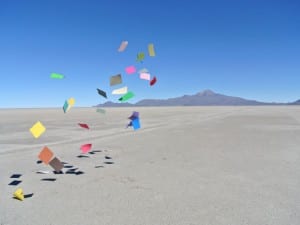In Nottingham Contemporary‘s latest exhibition, 20 international artists reflect upon the ecological, economic, political, and cultural crises of our modern world, opening up topics such as the current and catastrophic climate change, runaway global warming, and environmental destruction worldwide. Rights of Nature reveals how contemporary art contributes to the global rethinking of our species’ relationship with other living things – upon whose regeneration and survival our future depends.
Today, the right of nature to exist free from destructive human practices is increasingly being recognized, with Earth no longer viewed as a supply of natural resources to be exploited by multinational capitalism. While this transformation is slowly becoming global, the Americas are ahead of the curve in pushing a cultural-political-philosophical revolution that is redefining our relationship with the world. Countries such as Bolivia and Ecuador have recently enshrined the rights of Mother Earth in their constitutions, and across the two continents new materialism, speculative realism, object-oriented ontology and new genres of eco-feminism are rethinking humanity’s relation to non-human life – demanding an egalitarian way of seeing humans and ecology as intertwined.
This research-intensive exhibition discovers how an international grouping of artists and activists are participating in this transformation. We trace eco-centric legal developments, Amerindian cosmologies referring to Pachamama (“Mother Earth”), and speculative object-oriented philosophy, to view a new conception of nature located within indigenous rights struggles, Earth law, and political ecology. Rights of Nature will occupy all four of Nottingham Contemporary’s galleries with works loosely arranged in geographical order as a journey from north to south across the Americas. In this way regional ecologies will come into focus – including the Amazon, the Central Andes and the Gulf of Mexico – along with the politics, economics, histories and traditions that have shaped them.
A larger historical backdrop is also apparent, beginning with the European conquest of indigenous people, the near-extermination of their cultures and habitats, and the exploitative and export-based economies that characterised the colonial era. Then follows the neo-colonial eras of American economic and political hegemony, and the neoliberal, US-backed period of military dictatorships in the 60s, 70s and 80s, whose ecological legacy is clear today.
The works derive from artists working worldwide; some are collectives (two run NGO-type organisations) and some are of indigenous backgrounds, whilst many are ecological researchers and commentators. In drawing, sculpture, installation, performance and film, Rights of Nature considers how a diverse set of practitioners have imagined a world that we want to live in: where “we” is no longer limited to an autonomous humanity.
Rights of Nature: Art and Ecology in the Americas, until 15 March 2015, Nottingham Contemporary, Weekday Cross, Nottingham, NG1 2GB.
Find out more at www.nottinghamcontemporary.org.
Follow us on Twitter @AestheticaMag for the latest news in contemporary art and culture.
Credits
1. Minerva Cuevas, Serie Hidrocarburos, 2007. Courtesy of the artist and kurimanzutto, Mexico City.




